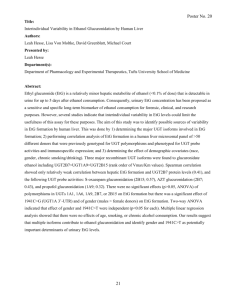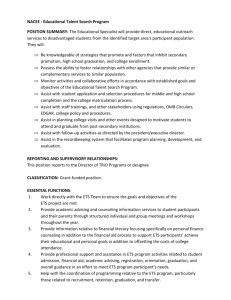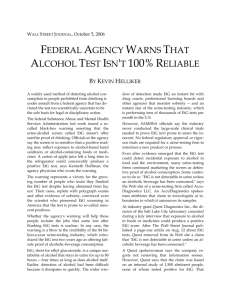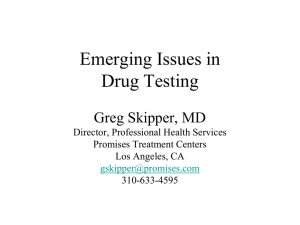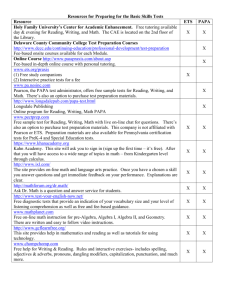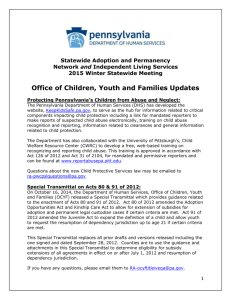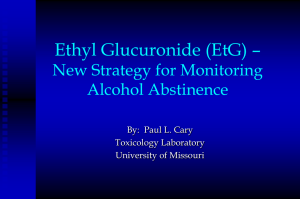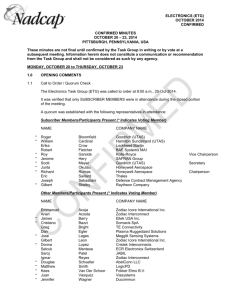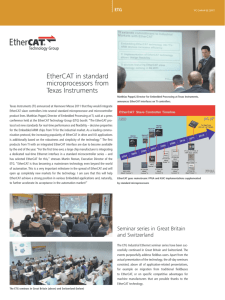Proper use of alcohol markers EtG and EtS in forensic settings.
advertisement
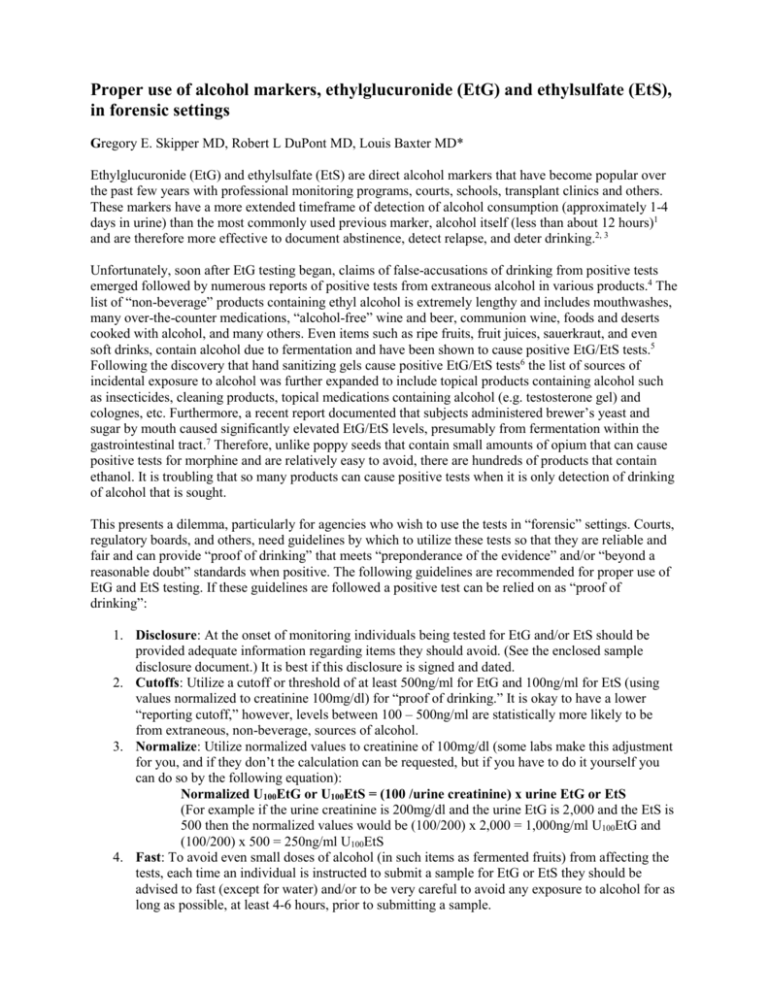
Proper use of alcohol markers, ethylglucuronide (EtG) and ethylsulfate (EtS), in forensic settings Gregory E. Skipper MD, Robert L DuPont MD, Louis Baxter MD* Ethylglucuronide (EtG) and ethylsulfate (EtS) are direct alcohol markers that have become popular over the past few years with professional monitoring programs, courts, schools, transplant clinics and others. These markers have a more extended timeframe of detection of alcohol consumption (approximately 1-4 days in urine) than the most commonly used previous marker, alcohol itself (less than about 12 hours)1 and are therefore more effective to document abstinence, detect relapse, and deter drinking.2, 3 Unfortunately, soon after EtG testing began, claims of false-accusations of drinking from positive tests emerged followed by numerous reports of positive tests from extraneous alcohol in various products.4 The list of “non-beverage” products containing ethyl alcohol is extremely lengthy and includes mouthwashes, many over-the-counter medications, “alcohol-free” wine and beer, communion wine, foods and deserts cooked with alcohol, and many others. Even items such as ripe fruits, fruit juices, sauerkraut, and even soft drinks, contain alcohol due to fermentation and have been shown to cause positive EtG/EtS tests.5 Following the discovery that hand sanitizing gels cause positive EtG/EtS tests6 the list of sources of incidental exposure to alcohol was further expanded to include topical products containing alcohol such as insecticides, cleaning products, topical medications containing alcohol (e.g. testosterone gel) and colognes, etc. Furthermore, a recent report documented that subjects administered brewer’s yeast and sugar by mouth caused significantly elevated EtG/EtS levels, presumably from fermentation within the gastrointestinal tract.7 Therefore, unlike poppy seeds that contain small amounts of opium that can cause positive tests for morphine and are relatively easy to avoid, there are hundreds of products that contain ethanol. It is troubling that so many products can cause positive tests when it is only detection of drinking of alcohol that is sought. This presents a dilemma, particularly for agencies who wish to use the tests in “forensic” settings. Courts, regulatory boards, and others, need guidelines by which to utilize these tests so that they are reliable and fair and can provide “proof of drinking” that meets “preponderance of the evidence” and/or “beyond a reasonable doubt” standards when positive. The following guidelines are recommended for proper use of EtG and EtS testing. If these guidelines are followed a positive test can be relied on as “proof of drinking”: 1. Disclosure: At the onset of monitoring individuals being tested for EtG and/or EtS should be provided adequate information regarding items they should avoid. (See the enclosed sample disclosure document.) It is best if this disclosure is signed and dated. 2. Cutoffs: Utilize a cutoff or threshold of at least 500ng/ml for EtG and 100ng/ml for EtS (using values normalized to creatinine 100mg/dl) for “proof of drinking.” It is okay to have a lower “reporting cutoff,” however, levels between 100 – 500ng/ml are statistically more likely to be from extraneous, non-beverage, sources of alcohol. 3. Normalize: Utilize normalized values to creatinine of 100mg/dl (some labs make this adjustment for you, and if they don’t the calculation can be requested, but if you have to do it yourself you can do so by the following equation): Normalized U100EtG or U100EtS = (100 /urine creatinine) x urine EtG or EtS (For example if the urine creatinine is 200mg/dl and the urine EtG is 2,000 and the EtS is 500 then the normalized values would be (100/200) x 2,000 = 1,000ng/ml U100EtG and (100/200) x 500 = 250ng/ml U100EtS 4. Fast: To avoid even small doses of alcohol (in such items as fermented fruits) from affecting the tests, each time an individual is instructed to submit a sample for EtG or EtS they should be advised to fast (except for water) and/or to be very careful to avoid any exposure to alcohol for as long as possible, at least 4-6 hours, prior to submitting a sample. Rationale: 1. Disclosure: Disclosure is required to participants in monitoring so they can be responsible to avoid products containing alcohol that could cause misleading test results. Disclosure should be as thorough as possible. 2. Cutoffs: The cutoffs for “proof of drinking” of 500ng/ml for EtG and 100ng/ml for EtS are reasonable based on the fact that most single exposure studies of extraneous sources of alcohol result in EtG levels below 500ng/ml and EtS levels less than 100ng/ml. It is acceptable for the “reporting cutoff” to be lower, however, levels under 500 for EtG and/or 100 for EtS are more suspicious as possibly being caused by incidental exposure. 3. Normalizing: Normalizing the values adjusts for the distorting effect of concentration (which can, in some cases, be significant). When urine is more concentrated all the values are skewed upward and when urine is more dilute the values are skewed downward. A calculation to adjust values to a creatinine of 100 “normalizes” and standardizes the results. 4. Fast: Fasting prevents items in the environment, such as aged fruit or fruit juices that contain slight amounts of alcohol, from causing brief elevations in EtG that can compound the likelihood that results could be misleadingly positive. Most of the effect from these items will dissipate within 6-8 hours. So it is most effective if an individual who has been notified to test is reminded to either fast or be particularly careful to avoid alcohol until the submit a sample. Other Approaches It is of note that some monitoring programs have started using blood phosphatidyl ethanol (PEth) in cases in which the EtG and/or EtS is positive and drinking is denied. PEth only becomes positive with more alcohol consumption than could occur from extraneous exposure and it can stay positive for several weeks and therefore it is being used to “confirm” drinking in these cases. In other words if PEth is positive it confirms drinking. If it is negative it only rules out excessive drinking as it cannot detect smaller amounts of alcohol. Using this type confirmation with or without the method mentioned above to improve the specificity of a positive EtG/EtS is acceptable. *Authors: – Gregory E. Skipper, MD is Medical Director of the Alabama Physician Health Program and was a principle innovator of EtG testing being brought to the United States in 2001. – Robert L DuPont, MD is the president of the Institute for Behavior and Health and was a former US Drug Czar and former head of the National Institute on Drug Abuse. – Louis Baxter, MD is the president of the American Society of Addiction Medicine and is the Medical Director of the New Jersey Physician Health PRogram Wurst F M, Skipper GE, Weinmann W (2003) Ethyl glucuronide – the direct ethanol metabolite on the threshold from science to routine use. Addiction 98 (Suppl 2) 51-61 2 Wurst F M., Vogel R., Jachau K., Varga A., Alling C., Skipper G.E., Alt A. (2003) Ethyl glucuronide detects recent alcohol use in forensic psychiatric inpatients. Alcohol Clin Exp Res 27: 471-476. 3 Skipper GE, Weinmann W, Theirauf A, Schaefer P, Wiesbeck G, Allen JP, Miller M, Wurst FM. Ethyl Glucuronide: A Biomarker to Identify Alcohol use by Health Professionals Recovering from Substance Use Disorders, Alcohol Alcohol. 2004 Sep-Oct;39(5):445-9. Epub 2004 Aug 2. 4 Costantino A, DiGregorio EJ, Korn W, Spayd S, Rieders F. The Effect of the Use of Mouthwash on Ethylglucuronide Concentrations in Urine. J of Anl Toxicol. 2006 Nov-Dec 30 pg 659-662. 5 Mushoff F, Albermann E, Madea B. Ethyl glucuronide and ethyl sulfate in urine after consumption of various beverages and foods – misleading results? Int J Legal Med DOI 10.1007/s00414-010-0511-z. 6 Rohrig TP, Huber C, Goodson L, RossW. Detectin of ethylglucuronide in urine following the application of GermX. J Anl Toxicol. 2006 Nov-Dec,30(9) 703-704. 7 Thierauf A, Wohlfarth A, Auwarter V, Perdekamp MG, Wurst FM, Weinmann W. Urine tested positive for ethyl glucuronide and ethyl sulfate after the consumption of yeast and sugar. Forensic Sci Int. 2010 Oct 10;202(1-3). Epub 2010 Jul 23. 1 Sample Disclosure: Client Contract Disclosure and Information when Monitoring with EtG/EtS Ethylglucuronide (EtG) and ethylsulfate (EtS) are metabolites of alcohol that are excreted more slowly from the body than alcohol itself. They are therefore better at detecting drinking and better at documenting abstinence. When being monitored with EtG/EtS, it is important, as in any monitoring situation, to be aware of items to avoid so that inadvertent "incidental" exposure does not cause a positive test. In other words, it's important to know what items contain alcohol and to avoid them. With reasonable caution it is rare for "incidental" alcohol exposure to cause a positive test. It is YOUR responsibility to limit and avoid exposure to products and substances that contain ethyl alcohol. It is YOUR responsibility to read product labels to know what is contained in the products you use and to inspect these products BEFORE you use them. Terms used to describe alcohol in products that must be avoided include: denatured alcohol, SD alcohol, ethanol or ethyl alcohol. Use of the products detailed below or any other product containing alcohol is a violation of this contract and will NOT be allowed as an excuse for a positive test result. When in doubt, don't use, consume or apply anything that might contain alcohol. Mouthwash: Many mouthwashes (i.e. Listermint, Cepacol, etc) contain ethyl alcohol. Use of alcohol containing mouthwashes can cause positive tests for alcohol because they contain a significant amount of alcohol. Participants are required to read product labels and avoid mouthwash or anything else containing ethyl alcohol. Use of alcohol containing products while in monitoring is not permitted. Non-alcohol mouthwashes are readily available and are an acceptable alternative. Over-the-counter medications: It has always been prohibited to use alcohol containing cough syrups or cold preparations (e.g. Nyquil) while in monitoring. Nutritional supplements, such as Ginko Biloba liquid, can contain alcohol and should be avoided. Any product called “tincture” contains alcohol. Alcohol is frequently used in liquid medications as a solvent. Read labels and if the product contains alcohol, don't use it unless you first receive clearance from your case manager. Non-alcohol containing cough and flu medications are readily available and are acceptable alternatives. Non-alcohol Beer and Wine: These beverages (e.g. O'Douls, Sharps, etc) contain enough alcohol that they can result in a positive test. While in monitoring you are not permitted to ingest these products. Food and Other Consumable Products: Flavoring extracts, such as vanilla extract or almond extract, if consumed in excess (e.g. to flavor coffee) can cause a positive test. Food cooked with wine or other alcoholic beverages has significant residual alcohol, even after cooking. Some desserts, especially flamed desserts, are prepared with large amounts of alcohol and can cause a positive test. Chocolates containing liquid filling can contain alcohol. Some churches use wine or fortified wine for communion and depending on how much is consumed can cause a positive test. All of these foods should be avoided. Breathing Alcohol Vapor Can Cause a Positive Test: Avoid breathing fumes of products containing alcohol, such as alcohol based handsanitizing gels (e.g. Purell), perfumes or colognes, bug sprays, or other chemicals (lacquers, solvents, or gasohol). If you must use these products use them sparingly and avoid breathing the fumes. Fasting: As an extra precaution to avoid extraneous items that might contain small amounts of alcohol from causing an effect on your test, we recommend that you essentially fast (except for water) for 4-6 hours prior to submitting a sample. This includes being careful to avoid breathing anything that contains alcohol. Most of these minor exposures only cause an effect for 4-6 hours or so. Strictly avoiding them prior to giving a sample will minimize the chances of a misleading positive test. Remember! When in doubt, don't use, consume or apply! I have read and understand my responsibilities detailed above: ______________________________________________________ Participant: Print and Sign Your Name ________________ Date
